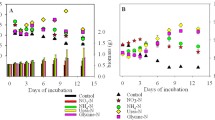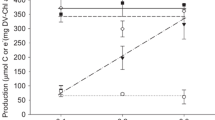Abstract
The availability of different forms of nitrogen in coastal and estuarine waters may be important in determining the abundance and productivity of different phytoplankton species. Although urea has been shown to contribute as much as 50% of the nitrogen for phytoplankton nutrition, relatively little is known of the activity and expression of urease in phytoplankton. Using an in vitro enzyme assay, urease activities were examined in laboratory cultures of three species: Aureococcus anophagefferens Hargraves et Sieburth, Prorocentrum minimum (Pavillard) Schiller, and Thalassiosira weissflogii (Grunow) Fryxell et Hasle. Cultures of P. minimum and T. weissflogii were grown on three nitrogen sources (NO3 −, NH4 +, and urea), while A. anophagefferens was grown only on NO3 − and urea. Urease was found to be constitutive in all cultures, but activity varied with growth rate and assay temperature for the different cultures. For A. anophagefferens, urease activity varied positively with growth rate regardless of the N source, while for P. minimum, urease activity varied positively with growth rate only for cultures grown on urea and NH4 +. In contrast, for T. weissflogii, activity did not vary with growth rate for any of the N sources. For all species, urease activity increased with assay temperature, but with different apparent temperature optima. For A. anophagefferens, in vitro activity increased from near 0–30°C, and remained stable to 50°C, while for P. minimum, increased in vitro activity was noted from near 0–20°C, but constant activity was observed between 20°C and 50°C. For T. weissfloggii, while activity also increased from 0°C to 20°C, subsequent decreases were noted when temperature was elevated above 20°C. Urease activity had a half-saturation constant of 120–165 μg atom N l−1 in all three species. On both an hourly and daily basis, urease activity in A. anophagefferens exceeded nitrogen demand for growth. In P. minimum, urease activity on an hourly basis matched the nitrogen demand, but was less than the demand on a daily basis. For T. weissflogii, urease activity was always less than the nitrogen demand. These patterns in urease activity in three different species demonstrate that while apparently constitutive, the regulation of activity was substantially different in the diatom. These differences in the physiological regulation of urease activity, as well as other enzymes, may play a role in their ecological success in different environments.






Similar content being viewed by others
References
Antia NJ, Landymore AF (1975) The non-biological oxidative degradation of dissolved xanthopterin and 2,4,6-trihydroxypteridine by the pH or salt content of seawater. Mar Chem 3:347–363
Antia NJ, Berland BR, Bonin DJ, Maestrini SY (1977) Effects of urea concentration in supporting growth of certain marine microplanktonic algae. Phycologia 16:105–111
Antia NJ, Harrison PJ, Oliveira L (1991) The role of dissolved organic nitrogen in phytoplankton nutrition, cell biology, and ecology. Phycologia 30:1–89
Bekheet IA, Syrett PJ (1977) Urea-degrading enzymes in algae. Br Phycol J 12:137–143
Berg GM, Glibert PG, Lomas ML, Burford M (1997) Organic nitrogen uptake and growth by the chrysophyte Aureococcus anophagefferens during a brown tide event. Mar Biol 129:377–387
Berg GM, Repeta DJ, Laroche J (2002) Dissolved organic nitrogen hydrolysis rates in axenic cultures of Aureococcus anophagefferens (Pelagophyceae): comparison with heterotrophic bacteria. Appl Environ Microbiol 68:400–404
Berges JA, Montagnes DJS, Hurd CL, Harrison PJ (1994) Fitting ecological and physiological data to rectangular hyperbolae: a comparison of methods using Monte Carlo simulations. Mar Ecol Prog Ser 114:175–183
Bronk DA, Glibert PM, Malone TC, Banahan S, Sahlsten E (1998) Inorganic and organic nitrogen cycling in Chesapeake Bay: autotrophic versus heterotrophic processes and relationships to carbon flux. Aquat Microb Ecol 15:177–189
Carpenter EJ, Remsen CC, Watson SW (1972) Utilization of urea by some marine phytoplankters. Limnol Oceanogr 17:265–269
Conover SAM (1975) Partitioning of nitrogen and carbon in cultures of the marine diatom Thalassiosira fluviatilis supplied with nitrate, ammonium, or urea. Mar Biol 32:231–246
Cosper EM, Dennison WC, Milligan A, Carpenter EJ, Lee C, Holzapfel J, Milanese L (1989) An evaluation of the environmental factors important to initiating and sustaining "brown tide" bloom. In: Cosper EM, Carpenter EJ, Bricelj WM (eds) Novel phytoplankton blooms: causes and impacts of recurrent brown tide and other unusual blooms. Springer, Berlin Heidelberg New York, pp 391–340
Furnas MJ (1983) Nitrogen dynamics in lower Narragansett Bay, Rhode Island. 1. Uptake by size-fractionated phytoplankton populations. J Plankton Res 5:657–676
Glibert PM (1998) Interactions of top-down and bottom-up control in planktonic nitrogen cycling. Hydrobiologia 363:1–12
Glibert PM, Terlizzi DE (1999) Co-occurrence of elevated urea levels and dinoflagellate blooms in temperate estuarine aquaculture ponds. Appl Environ Microbiol 65:5594–5596
Glibert PM, Garside C, Fuhrman JA, Roman MR (1991) Time-dependent coupling of inorganic and organic nitrogen uptake and regeneration in the plume of the Chesapeake Bay estuary and its regulation by large heterotrophs. Limnol Oceanogr 36:895–909
Glibert PM, Conley DJ, Fisher TR, Harding LW, Malone TC (1995) Dynamics of the 1990 winter/spring bloom in Chesapeake Bay. Mar Ecol Prog Ser 122:27–43
Glibert PM, Magnien R, Lomas MW, Alexander J, Fan C, Haramoto E, Trace M, Kana TM (2001) Harmful algal blooms in the Chesapeake and coastal bays of Maryland, USA: comparison of 1997, 1998, and 1999 events. Estuaries 24:875–883
Harrison WG, Head EJH, Conover RJ, Longhurst AR, Sameoto DD (1985) The distribution and metabolism of urea in the eastern Canadian Arctic. Deep-Sea Res 32:23–42
Harvey WA, Caperon J (1976) The rate of utilization of urea, ammonium, and nitrate by natural populations of marine phytoplankton in a eutrophic environment. Pac Sci 30:329–340
Jahns T, Schafer U, Kaltwasser H (1995) Heat-stable ureases from two filamentous cyanobacteria. Microbiology 141:737–741
Kaufman ZG, Lively JS, Carpenter EJ (1983) Uptake of nitrogenous nutrients by phytoplankton in a barrier island estuary: Great South Bay, New York. Estuar Coast Shelf Sci 17:483–493
Kirchman DL (1990) Limitation of bacterial growth by dissolved organic matter in the subarctic Pacific. Mar Ecol Prog Ser 62:47–54
Kudela RM, Cochlan WP (2000) Nitrogen and carbon uptake kinetics and the influence of irradiance for a red tide bloom off southern California. Aquat Microb Ecol 21:31–47
Leftley JW, Syrett PJ (1973) Urease and ATP:Urea amiodolyase activity in unicellular algae. J Gen Microbiol 77:109–115
Lomas MW, Glibert PM (1999) Temperature regulation of nitrate uptake: a novel hypothesis about nitrate uptake and reduction in cool-water diatoms. Limnol Oceanogr 44:556–572
Lomas MW, Glibert PM (2000) Comparisons of nitrate uptake, storage, and reduction in marine diatoms and flagellates. J Phycol 36:903–913
Lomas MW, Glibert PM, Clougherty DA, Huber DE, Jones J, Alexander J, Haramoto E (2001) Elevated organic nutrient ratios associated with brown tide blooms of Aureococcus anophagefferens (Pelagophyceae). J Plankton Res 23:1339–1344
Margalef R (1978) Life-forms of phytoplankton as survival alternatives in an unstable environment. Oceanol Acta 1:493–509
McCarthy JJ (1972) The uptake of urea by natural populations of marine phytoplankton. Limnol Oceanogr 17:738–748
McCarthy JJ (1977) Nitrogenous nutrition of the plankton in the Chesapeake Bay. 1. Nutrient availability and phytoplankton preferences. Limnol Oceanogr 22:996–1011
McCarthy JJ (1980) Nitrogen and phytoplankton ecology. In: Morris I (ed) The physiological ecology of phytoplankton. Blackwell, Oxford, pp 191–233
Mobley HLT, Hausinger RP (1989) Microbial urease: significance, regulation, and molecular characterization. Microbiol Rev 53:85–108
Oliveira L, Antia NJ (1986) Some observations on the urea-degrading enzyme of the diatom Cyclotella cryptica and the role of nickel in its production. J Plankton Res 8:235–242
Paerl HW (1988) Nuisance phytoplankton blooms in coastal, estuarine, and inland waters. Limnol Oceanogr 33:823–847
Parsons TR, Maita Y, Lalli CM (1984) A manual of chemical and biological methods for seawater analysis. Pergamon, New York
Peers SG, Milligan AJ, Harrison PJ (2000) Assay optimization and regulation of urease activity in two marine diatoms. J Phycol 36:523–528
Price NM, Harrison PJ (1988) Uptake of urea C and N by the coastal marine diatom Thalassiosira pseudonana. Limnol Oceanogr 33:528–537
Singh S (1990) Regulation of urease activity in the cyanobacterium Anabaena doliolum. FEMS Microbiol Lett 67:79–84
Smayda TJ (1990) Novel and nuisance phytoplankton blooms in the sea: evidence for a global epidemic. In: Graneli E, Sundstroem B, Edler L, Anderson DM (eds) Proceedings of the 4th international conference on toxic marine phytoplankton. Toxic marine phytoplankton. Elsevier, New York, pp 29–40
Smayda TJ (1997) Harmful algal blooms: their ecophysiology and general relevance to phytoplankton blooms in the sea. Limnol Oceanogr 42:1137–1153
Takahashi M, Fukazawa N (1982) A mechanism of "red-tide" formation. 2. Effect of selective nutrient stimulation on the growth of different phytoplankton species in natural water. Mar Biol 70:267–273
Thomas WH (1968) Nutrient requirements and utilization: algae. In: Altman PL, Dittmer DS (eds) Metabolism. Federation of American Societies for Experimental Biology, Bethesda, Md., pp 210–228
Turley CM (1986) Urea uptake by phytoplankton at different fronts and associated stratified and mixed waters on the European shelf. Br Phycol J 21:225–238
Acknowledgements
We thank the Analytical Services Laboratories of the Horn Point Laboratory for technical assistance. Additional assistance was provided by E. Haramoto. This study was supported by the U.S. ECOHAB Program, sponsored by the National Oceanic and Atmospheric Administration, U.S. Environmental Protection Agency, National Science Foundation, National Aeronautics and Space Administration, and Office of Naval Research. This is contribution number 3628 from the University of Maryland Center for Environmental Science, and number 64 from the U.S. ECOHAB Program.
Author information
Authors and Affiliations
Corresponding author
Additional information
Communicated by J.P. Grassle, New Brunswick
Rights and permissions
About this article
Cite this article
Fan, C., Glibert, P.M., Alexander, J. et al. Characterization of urease activity in three marine phytoplankton species, Aureococcus anophagefferens, Prorocentrum minimum, and Thalassiosira weissflogii . Marine Biology 142, 949–958 (2003). https://doi.org/10.1007/s00227-003-1017-8
Received:
Accepted:
Published:
Issue Date:
DOI: https://doi.org/10.1007/s00227-003-1017-8




